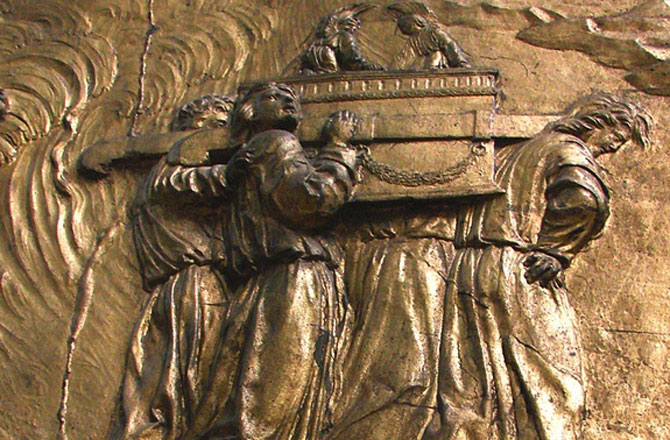University of St Andrews professor, James Davila, is the first to translate an ancient Hebrew text, the Massekhet Kelim (“Treatise of the Vessels”), into English. Davila’s translation of the text, taken from the 1648 Hebrew book, Emek Halchah, reveals further information about the whereabouts of King Solomon’s treasures.

Image showing the Ark of the Covenant being carried, Auch Cathedral, France. Photo by I. Vassil, released into public domain through Wikimedia
King Solomon, the third King of Israel who ruled for 40 years from 965BC to 925BC, remains a popular figure from ancient history. He has been documented as being incredibly wise and a very extravagant king. The Book of Kings makes reference to his 700 wives and parts of the Bible claim that he composed 1005 songs and 3000 proverbs. Amongst the many treasures belonging to King Solomon, lost when his temple was annihilated by the Babylonians during 597 and 586 B.C., was the infamous Ark of the Covenant (a gilded case which was constructed almost 3,000 years ago, to hold the Ten Commandments given by God to Moses, by the Israelites).
Davila’s translation of the Treatise of the Vessels, the first ever translation to have been made of the text into English, brings to light a number of references which allude to the possible whereabouts of King Solomon’s treasures and the Ark of the Covenant. The snag is that the references made are vague to say the least and even Professor Davila himself believes that whoever wrote the original script in Hebrew was influenced in his/her writings by popular legends and a variety of scriptural interpretation methods that would have formed part of the traditional methodology used at the time.
However, at the same time as referring to the Treatise of the Vessels as “entertaining fiction,” Davila is also quick to note the striking similarities between what is written in the Hebrew text he has just finished translating and what has already been revealed through earlier translations of the “Copper Scroll.” The Copper Scroll, thought to be about 1900 years old, is made of copper and makes references to the location and contents of hidden treasures. Both artefacts refer to “vessels” or “implements”, made of silver and gold. One particular section of the Treatise of the Vessels translates to, “seventy-seven tables of gold, and their gold was from the walls of the Garden of Eden that was revealed to Solomon, and they radiated like the radiance of the sun and moon, which radiate at the height of the world.”
Davila believes that the writer of the Hebrew text was simply creating an entertaining story. He doesn’t believe that the writer created the text to act in any way as a map to help others find King Solomon’s lost temple treasures. Davila also believes that the style of the writing in the text also lends us some interesting insights into the many kinds of Jewish legends that were popular during the Middle Ages. Professor Davila is further quick to add that this text helps us to see the many ways in which people during the Middle Ages understood and interpreted the Bible and how these interpretations are not part of the official interpretations that we have studied over time.
Whether the text refers to the same hidden treasures or not, the actual location of such wealth is not revealed in the text at any stage. There’ll be no Indiana Jones-like crusade for Professor Davila in the coming weeks, but the translation does at least provide another entertaining piece of fiction… particularly for those with a real interest in ancient history and a fetish for rich, extravagant King Solomon.




Why do you call the ark of the covenant “infamous”??? Very offensive!